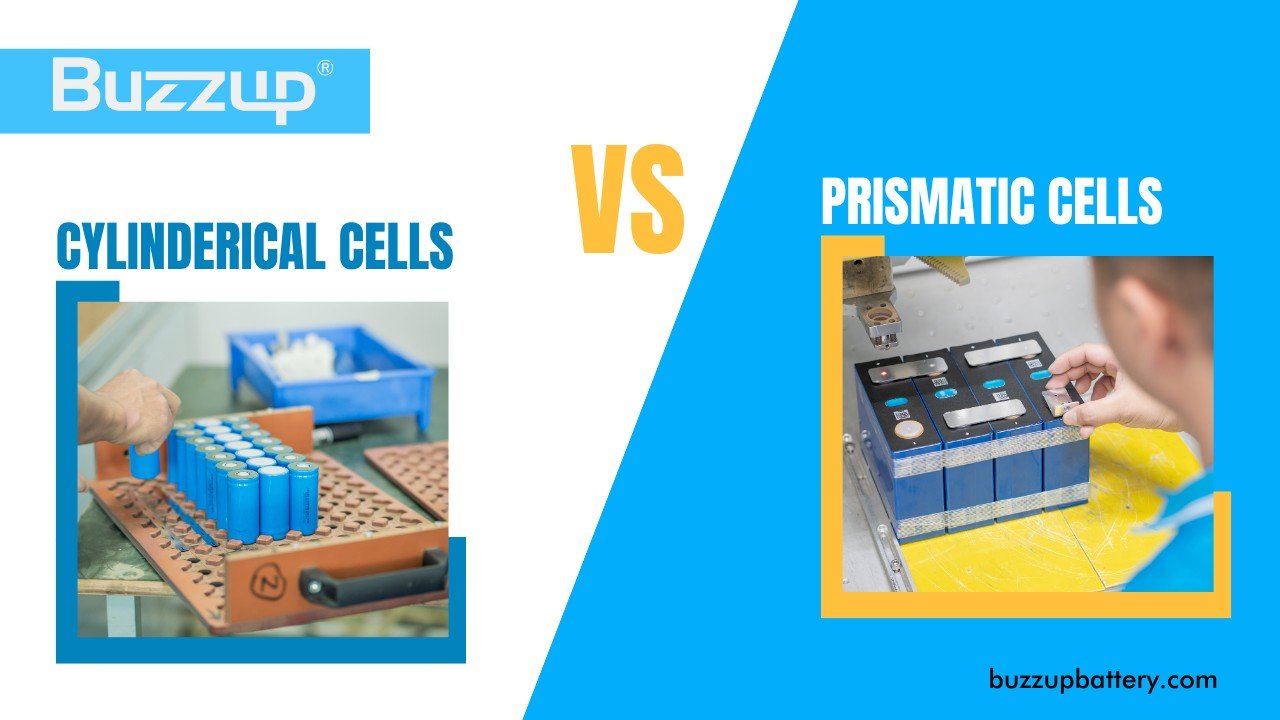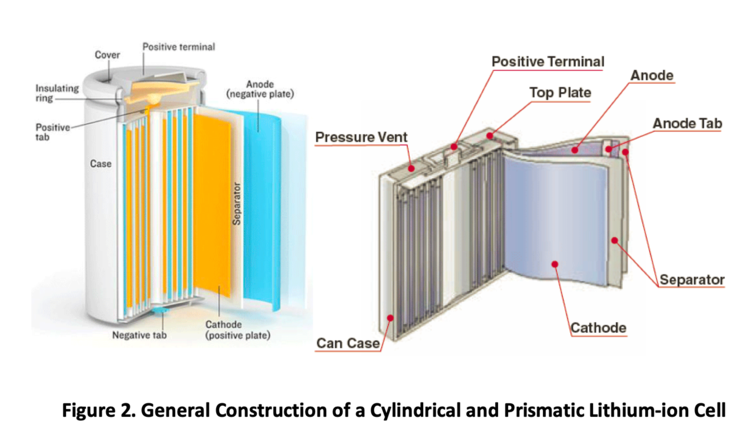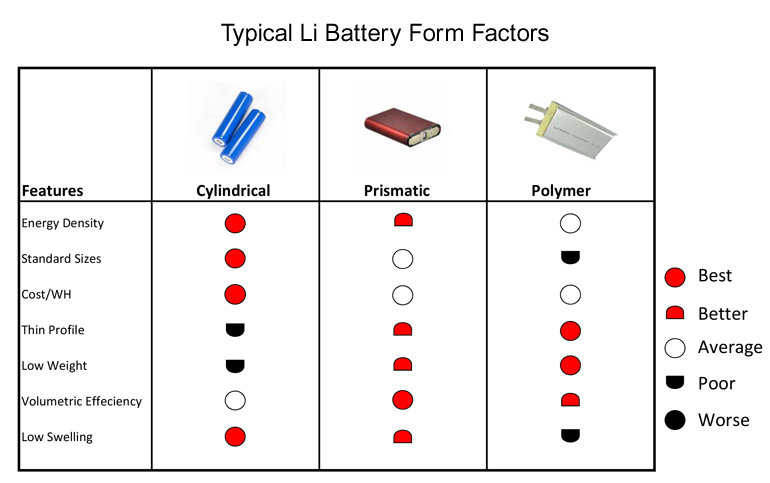
Lithium-ion cells spring to mind when one considers the core of batteries. Of course, these cells have always remained a priority for general or specialized usage. The lithium-ion cells are currently the most powerful rechargeable battery available. These battery cells are showing a huge success in every application. These cells are the best option for power storage, electric cars, and other uses.Well, the structure of the battery is vital to the pack as a whole. As you know, the two most popular forms of rechargeable batteries are prism-shaped and cylindrical-shaped LiFePO4. These two cells offer various benefits, and an ideal selection depends on the need.
So, let’s look at the two most prevalent cell types. We will discuss their advantages and disadvantages. Moreover, we will also analyze the situations where they are most in use.
Prismatic Cells: What Are They?
These cells consist of a hard shell around their structure. It comes in a flat form, making it ideal for use in various applications.
It has a cell’s case with three electrode sheets, an anode, a separator and a cathode. These electrode sheets are vertical, folded, or flattened inside the prismatic cells’ case. As a result, this opens the door to significant benefits straight away.
Prismatic lithium batteries have unique compositions and designs. It allows them to have a slim, lightweight, and space-efficient structure. Thus, they are ideal for energy storage, power backup, and electric powertrains.
Cylindrical Cells: What Are They?
This cell is somewhat confined with a tube-like structure. Moreover, these cells are also compact. Thus, you can set them in devices of varying dimensions.Its unique design eliminates gas buildup in conventional battery cases. As a result, it puts an end to the undesirable issue of bloating in cells.
In a battery, you will notice that these cells are aligned to each other. This procedure aids the voltage and total size of the battery pack. Moreover, this unique construction curtails the possibility of disintegration of internal electrode material. It performs well even under extreme stress.
Cylindrical Cells vs. Prismatic Cells – The Key Differences

Image Source: https://www.exploringoverland.com/overland-tech-travel/2021/3/29/lifepo4-battery-cylindrical-cells-or-prism-cells
Batteries come in different sizes depending on the device they power. Likewise, their cell forms also come in a wide range of sizes and chemical compositions.
Learn more about batteries by studying their structure, cost, and requirements. It will help you understand the price of battery components and their makeup.
1) Shape
Well, these two cells are uniquely designed. Besides, they may house a variety of components. Cylindrical cells are comparable to the ones used in devices like remote controls. Also, they are wide and tubular in shape.
Ions are tightly wrapped and then enclosed to create this product. After that, they go into a custom-made metal tin.
Moreover, dimensions are somewhat compact with this form. Standard cylindrical cell formats include –
- 14650
- 18650
- 21700
- 26500
The components are encased between two flat surfaces. Also, they are compressed to form the structure of a prism. Space efficiency is the primary advantage of these cells.
There is a wide range in the dimensions of prism-like cells. Manufacturers are not required to use the same style forms. Thus, they are free to create a variety of unique forms.
2) Heat
As we know, it is impossible to pack cylindrical cells tightly. Their shape restricts us from doing so. Thus, there will be many empty areas among them. These areas allow heat to escape.
3) Build
Once assembled, cylindrical cells don’t fit perfectly. It makes room for air to flow and heat to escape, enabling the power source to operate safely and at peak efficiency even as temperatures rise.
On the other hand, prismatic ones are larger and more capacious. Thus, these cells constitute a distinct cellular form. Prismatic packs are often more compact because their cell structure permits close organizing.
However, this compactness comes at the expense of ventilation and temperature control. As a result, the battery is vulnerable to overheating since there is no ventilation for the cells.
4) Simple to Create
Many people are considering battery capacity now since it’s necessary for most situations.
Compared to other cells and their shapes, cylindrical ones are quite challenging to expand. These cells will require many thousands of cells to achieve a comparable capability.
However, it’s possible that prismatic cells merely require a tiny number, so that’s all we need. As a result, developing prismatic cells is less complicated.
5) Number of Connections
Prismatic is more efficient as opposed to cylindrical ones. They can produce an equal quantity of energy since they are bigger.
It implies that there are fewer electrical connections to solder within batteries that employ prismatic cells, despite the fact that the capacity remains the same.
Due to this, prismatic cells have a much lower failure rate throughout production.
6) Making Use of Available Area
That’s a crucial difference to make. Cylindrical ones don’t have a more efficient use of space than their other counterparts. Moreover, the cylindrical kind will always have empty spaces.
But the prism-like rectangular form makes it possible to group the cells closer.
7) Cell Life
Well, cylindrical cells have a substantially longer lifespan. Most of them considerably outlive their declared duration. That’s because they are not restricted by DoD and may be drained entirely without damage. So the average lifetime of a cylindrical cell can be up to five hundred cycles.
So what about the prismatic cell? Well, the C-rating and Depth of Discharge (DoD) are relatively modest. However, their life cycles are pretty long. The average lifespan of prismatic ones might be approximately two thousand cycles.
8) Failure of One Cell
There is one more aspect of a cell’s lifetime. Make sure you know the way the failure of even a single cell may affect the performance of the whole battery.
Because of the serial connection, a single defective cell may affect the whole battery assembly. It happens in a prismatic cell.
So what if a single cylindrical cell fails? Well, the rest of the pack can keep going as long as its capacity is higher than the smallest one.
9) Variations in the Chemistry
The cylindrical cell’s unique design and layout make ion dispersion within the cell relatively consistent. Most electrolytes might turn inactive on the cell’s innermost edges.
On the other hand, the prismatic design exerts a little force. In short, these cells might employ less ions.
10) Weight
Many cylindrical cells include steel casings. Thus, their weight will be greater. Modern prismatic cells feature aluminum casings, making them considerably lightweight.
11) Power
While cylindrical ones provide higher power, they might hold fewer kWh compared to their counterparts.
Thus, cylindrical ones are capable of energy dissipation at a quicker rate compared to other cells. They are superior because of their higher connection density.
Therefore, prismatic cells are best for maximizing power yield. On the other hand, cylindrical cells are best for smaller and bigger applications.
12) Density of Energy
Because of their unique shape, prismatic ones have a somewhat greater density. Likewise, it will be less in cylindrical ones.
13) The Price
What will you do after looking at the battery price? Of course, you might prefer to check its type.
Cylindrical cells are less expensive to produce. That’s because the necessary technology has been available for decades.
However, costs for prismatic ones will vary depending on factors such as cell dimension and quantity ordered.
In addition, consumers must factor in the additional expenses of inspection, packaging, and shipping of battery cells.
Is It Easier To Produce A Cylindrical Cell Or A Prismatic One?
The production price of cylindrical cells will be lower than prismatic cells. Of course, these cells boast a drawn-out history. Moreover, they need less complicated treatment and manufacturing technologies.
On the one hand, the making expenses for prismatic cells are now more significant than they might be. Technological constraints and a lack of industry-wide standardization are the reasons. Also, they are not mass-produced items.
Well, you need to know that most producers want the manufacturing process to be profitable. Yet, they don’t want to produce in small order quantities.
Thus, it may be challenging to get a few samples. You should inquire about the quantities your battery supplier runs if you need fewer than a thousand units.
Remember, it needs an independent lab and various units if you want to do a sample evaluation. Thus, this option may only turn sensible if your expected yearly buy is above that amount.
Which Is Better – Prismatic or Cylindrical Cells?

Image Source: https://www.researchgate.net/post/Do-the-performance-in-terms-of-life-cycle-energy-density-vary-with-different-shapes-cylindrical-pouch-and-prismat-of-same-lithium-ion-chemistry
Cylindrical lithium batteries are often utilized because of their convenience and affordability. The production duration and price per kWh are both reduced.
As a result, they can be a viable option for high-power lithium. Not only that, but it is also long-lasting and places little emphasis on compact design.
Likewise, prismatic ones are well-known in recent years. And we know them for their high energy density. They can link four cells in building a product by having an inherent prismatic structure.
Besides, a prismatic cell may be preferable if the project requires compact dimensions. Remember, you have to pay a premium for it.
What Factors Should You Consider Before Buying Cylindrical and Prismatic Cells?
Whether you plan to buy cylindrical or prismatic cells, consider the following factors.
1) Form factor
2) Battery chemistry
3) Battery datasheet
4) Manufacturer’s experience
Where Can You Get High-Quality Cylindrical and Prismatic Cells?
Buzzup has received recognition as one of the industry’s leading battery manufacturers. Our cylindrical and prismatic cells provide the fundamental strength to support high-power appliances. Contact Buzzup to get high-quality cylindrical and prismatic cells at wholesale prices.
Final Thoughts!
Nowadays, customers consider the most widely available alternatives for constructing lithium batteries. So you can give them the choice of cylindrical and prismatic cells. Moreover, you can also explain the guidelines above for each cell type.
When high power, extended service life, and superior performance are more important than compactness, a cylindrical cell may be the ideal option for your customer.
On the other hand, a prismatic cell may be preferable if the application has space constraints, but a higher cost threshold is still tolerable.
No matter which cell type your customers prefer to buy, you should always keep stock of both cell types. Get in touch with Buzzup to place your first order.


